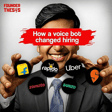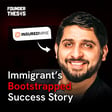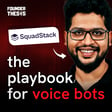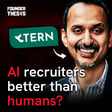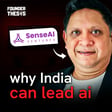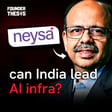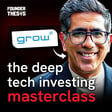
How AI Handles 30 Lakh Calls Daily in 10+ Languages | Manish & Rashi Gupta (Rezo.ai)
"In our current capacity, we are 100 people strong working equivalent to 20,000 Warm Bodies."
This staggering metric from Manish Gupta highlights the sheer efficiency and disruptive potential of AI in traditional industries like call centers. Rezo.ai isn't just automating tasks; it's achieving workforce multiplication through technology, fundamentally changing how businesses scale customer interactions.
Meet the Guests: Manish Gupta & Rashi Gupta (Ph.D.) are the Co-Founders of Rezo.ai, the husband-and-wife duo revolutionizing customer experience with AI. Manish (CEO) holds an M.Tech from IIT Delhi and previously served as CTO at RateGain. Rashi, a data science expert, earned her Ph.D. from the University of Helsinki and two Master's degrees from IIT Delhi. Together, they've built Rezo.ai into a profitable venture (for 8 consecutive quarters!) handling 30 lakh calls daily and targeting a $10 Million ARR.
Key Insights from the Conversation:
- Value-Based Pricing: Shifting from simple rate cards to demonstrating clear ROI based on the enterprise's cost savings and value gained was key to unlocking larger B2B deals.
- Human + AI Collaboration: AI excels at handling high-volume, short (<3 min) interactions, freeing up human agents for complex, empathetic, or emergency situations requiring a human touch.
- Vernacular is Crucial: Supporting multiple Indian languages (10+) is essential for the Indian market, requiring sophisticated NLP and speech engines beyond simple translation.
- AI Augmentation, Not Replacement: Implementing AI hasn't led to agent layoffs; instead, employees are upskilled and redeployed for higher-value tasks.
- Enterprise AI Needs Guardrails: While powerful, generative AI like ChatGPT needs careful implementation with boundaries in B2B settings to ensure compliance and prevent brand damage.
- Funding Purpose: Raise capital strategically to fuel growth (like US expansion), not just because VC money is available.
Chapters:
- 0:00 - Intro: Meet Manish & Rashi Gupta
- 1:18 - What is Rezo.ai? The AI-Powered Call Center Explained
- 2:23 - The Human Touch: Where AI Stops & Agents Step In
- 5:46 - Founder Journey: IIT Days, First Startup Failure & Rezo's Genesis
- 10:18 - Finding PMF: Pivoting from Text Chatbots to Voice AI
- 16:02 - Landing Maruti: Building Trust & Vernacular Voice Capability
- 19:04 - Tech Deep Dive: Speech Engines, NLP & Handling Indian Languages
- 26:58 - Integrating Generative AI (ChatGPT) Responsibly
- 31:57 - Pricing B2B AI: The Power of Value-Based Selling
- 38:39 - Rapid Deployment: Onboarding Enterprise Clients in Days
- 49:48 - Scaling & Profitability: Reaching $10M ARR Target
- 51:43 - Funding Strategy & US Expansion Plans
- 55:35 - Competition & Advice for Aspiring Founders
Hashtags: #RezoAI #ManishGupta #RashiGupta #AICallCenter #ConversationalAI #VoiceAI #CustomerExperience #CX #B2BStartup #SaaS #EnterpriseAI #StartupIndia #IndianStartups #IITDelhi #FounderThesis #Podcast #AIinIndia #VernacularAI #NLP #MachineLearning #Profitability #Bootstrapping #ValueBasedPricing #FutureOfWork #Automation #CustomerSupport #TechPodcast #Entrepreneurship

